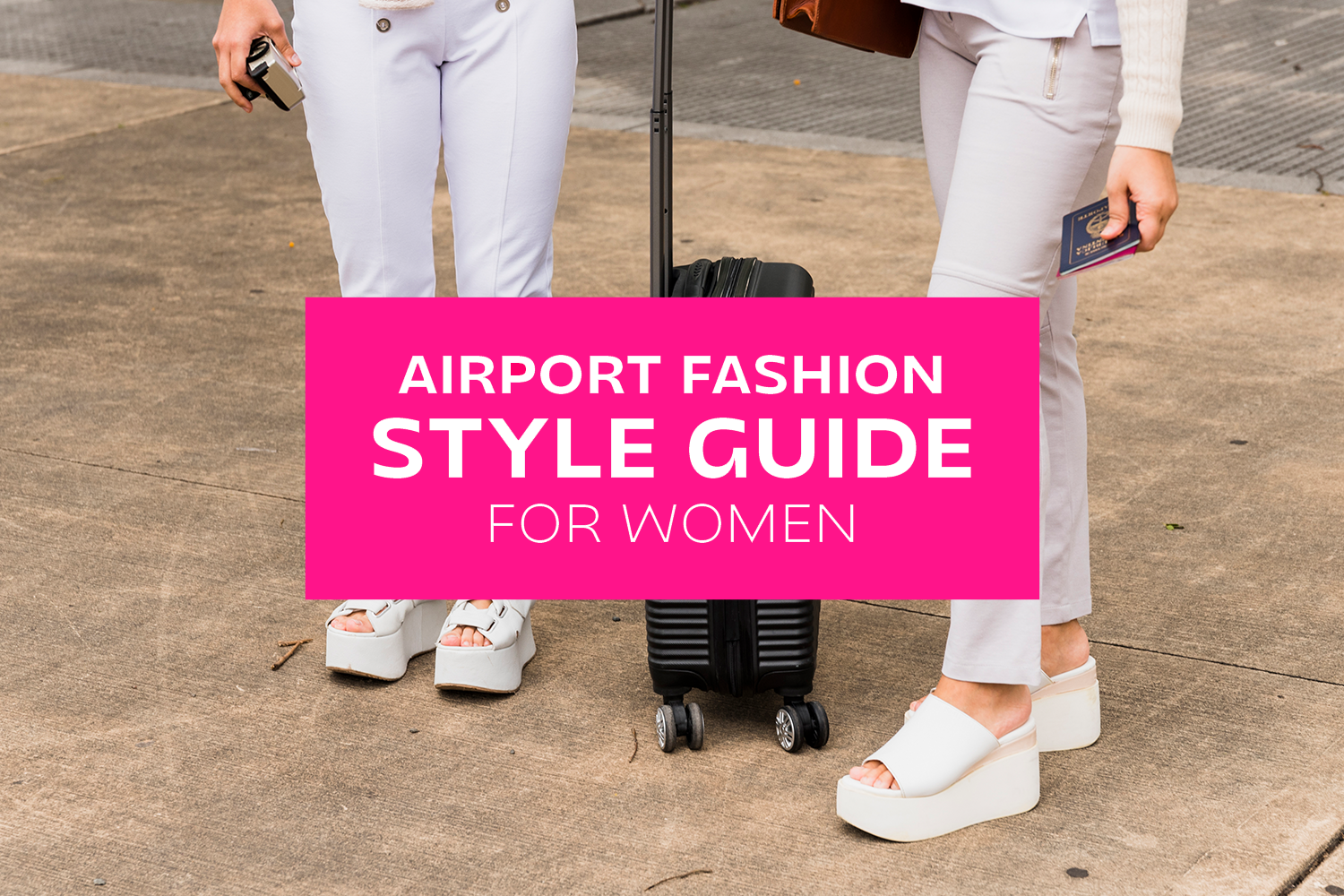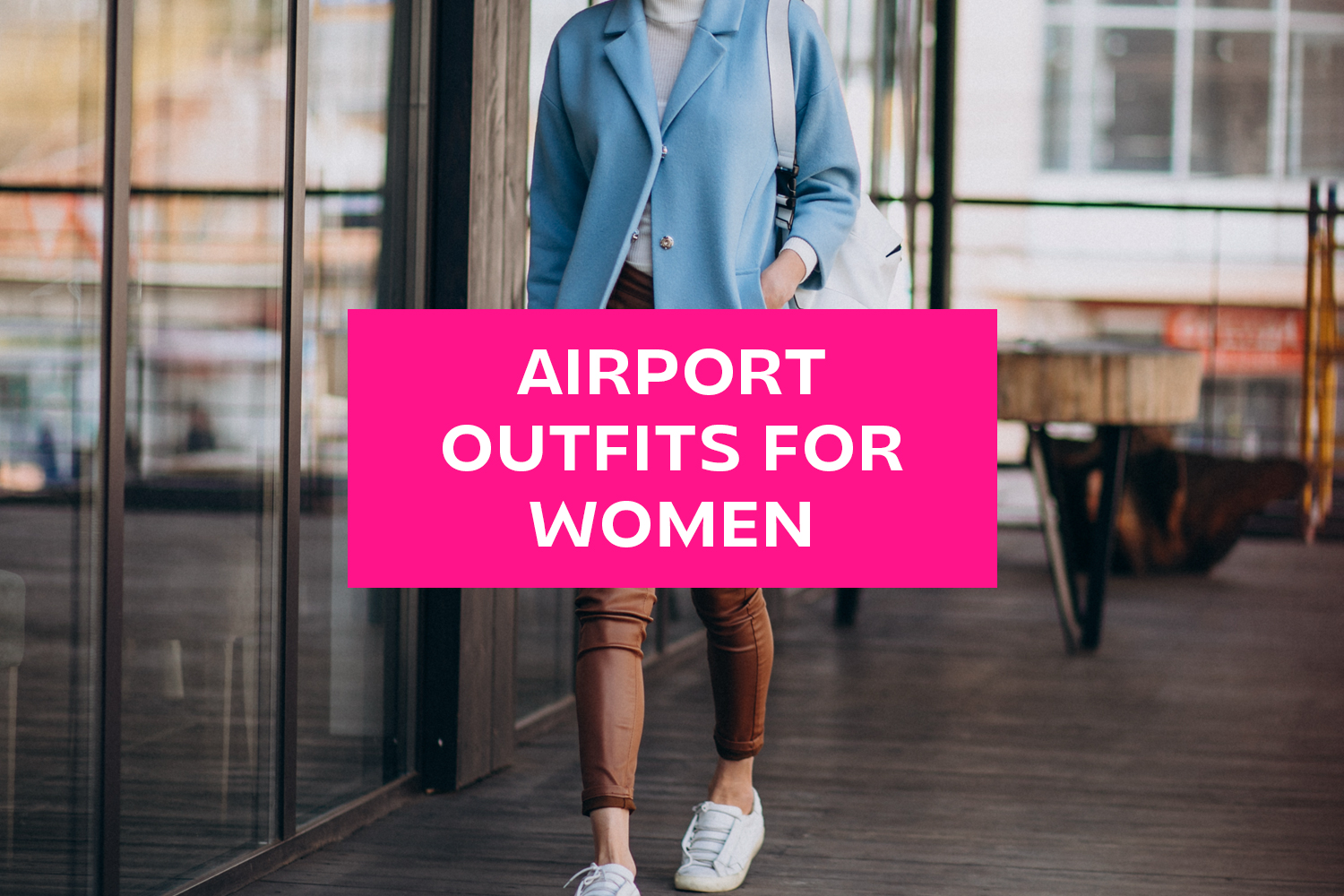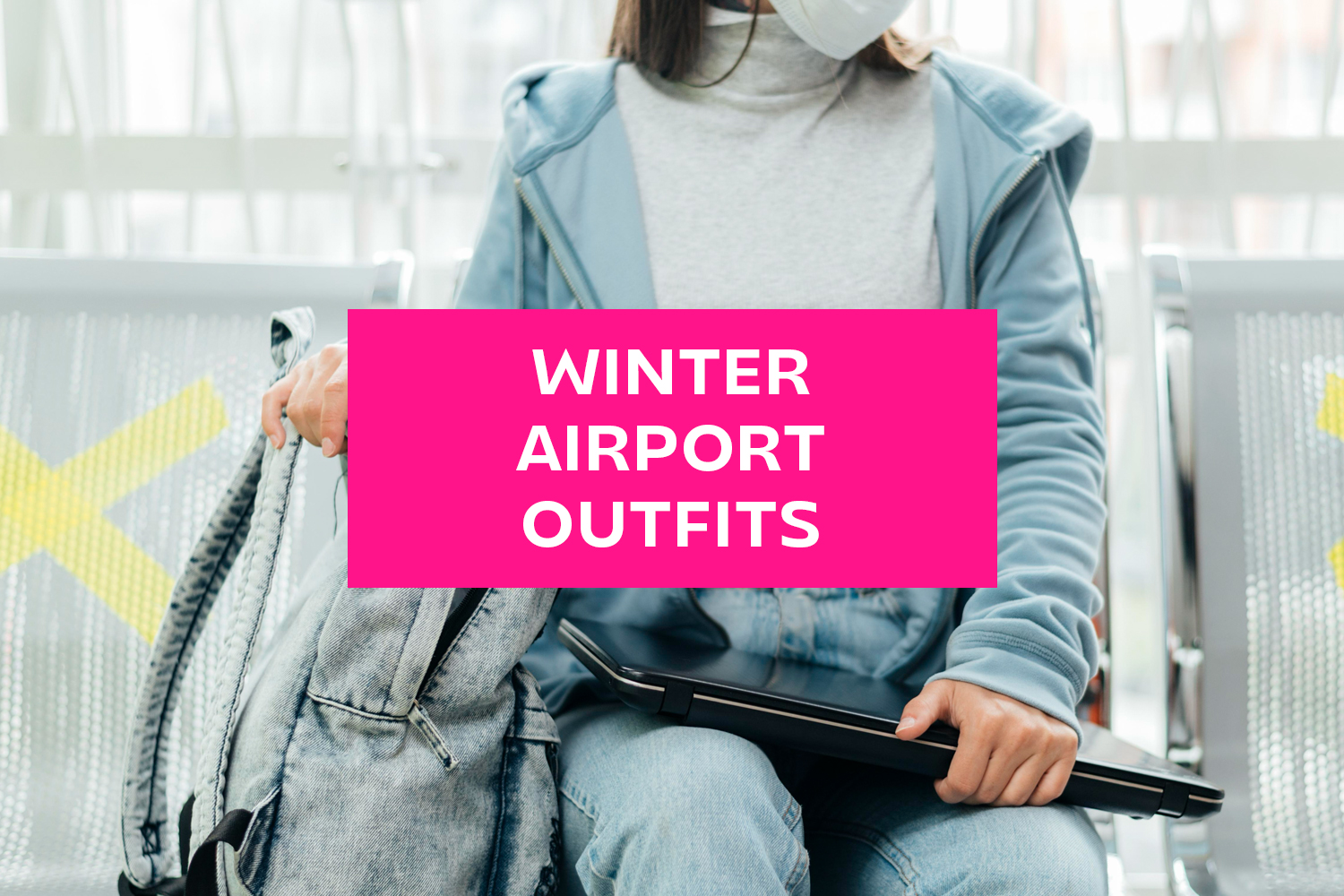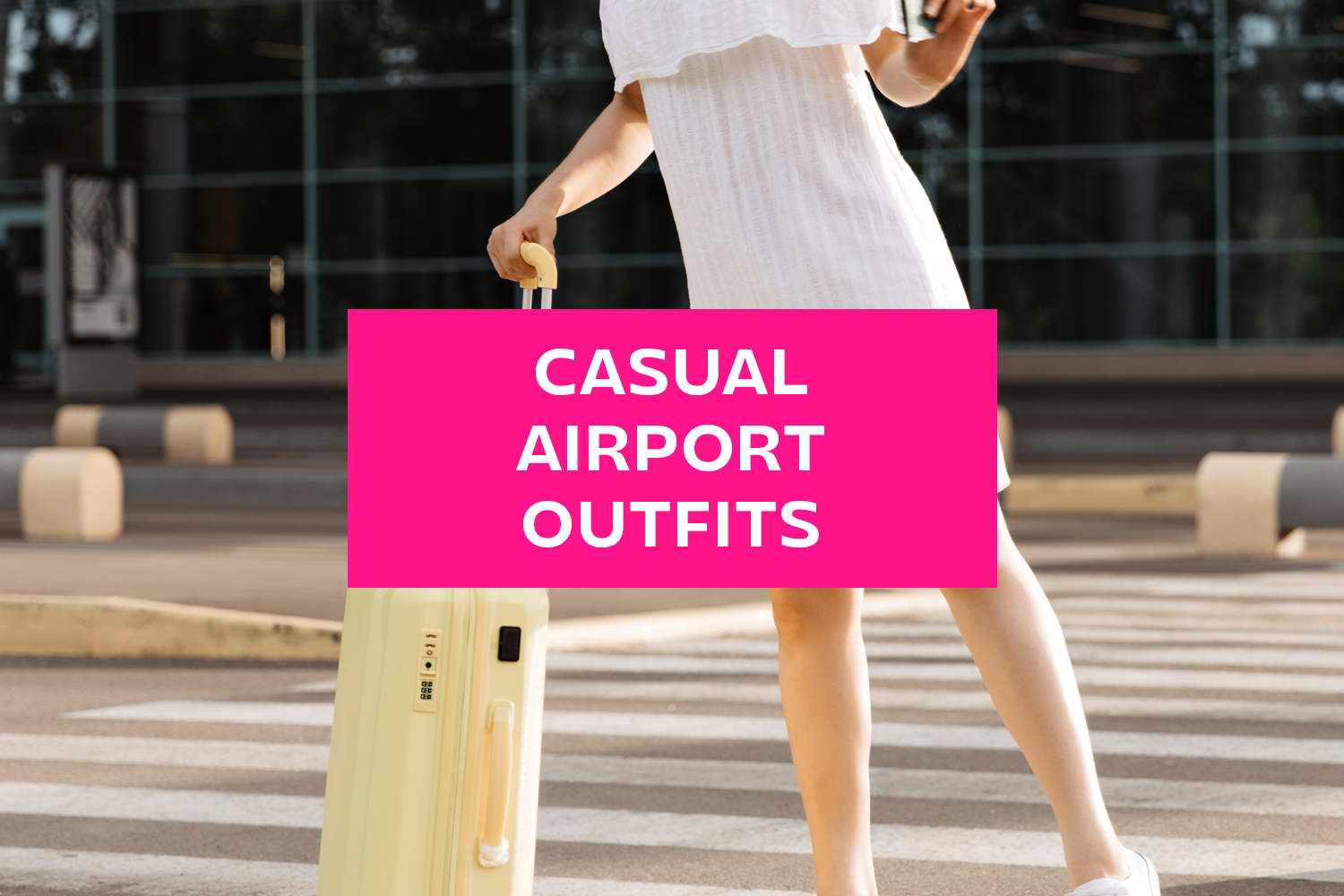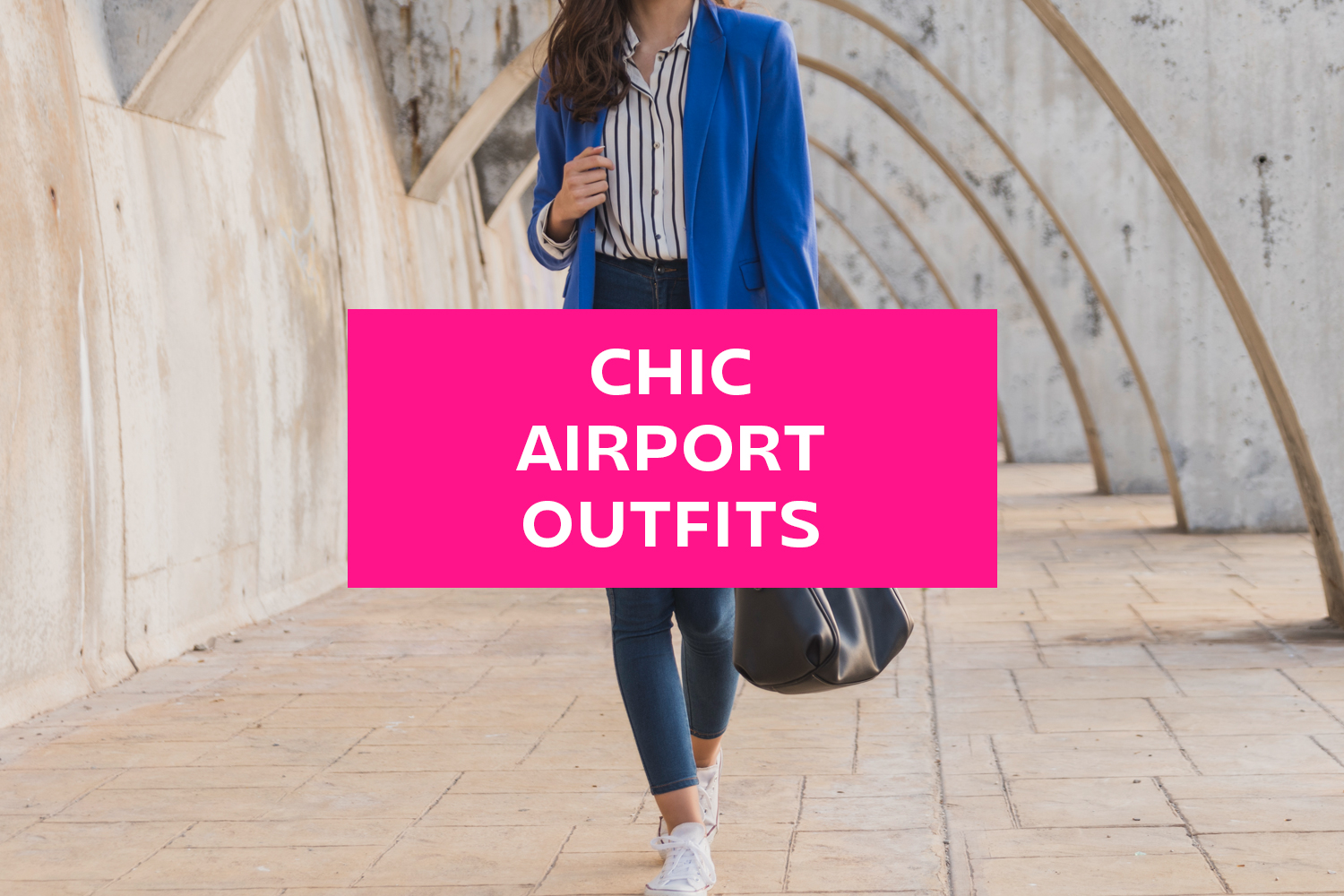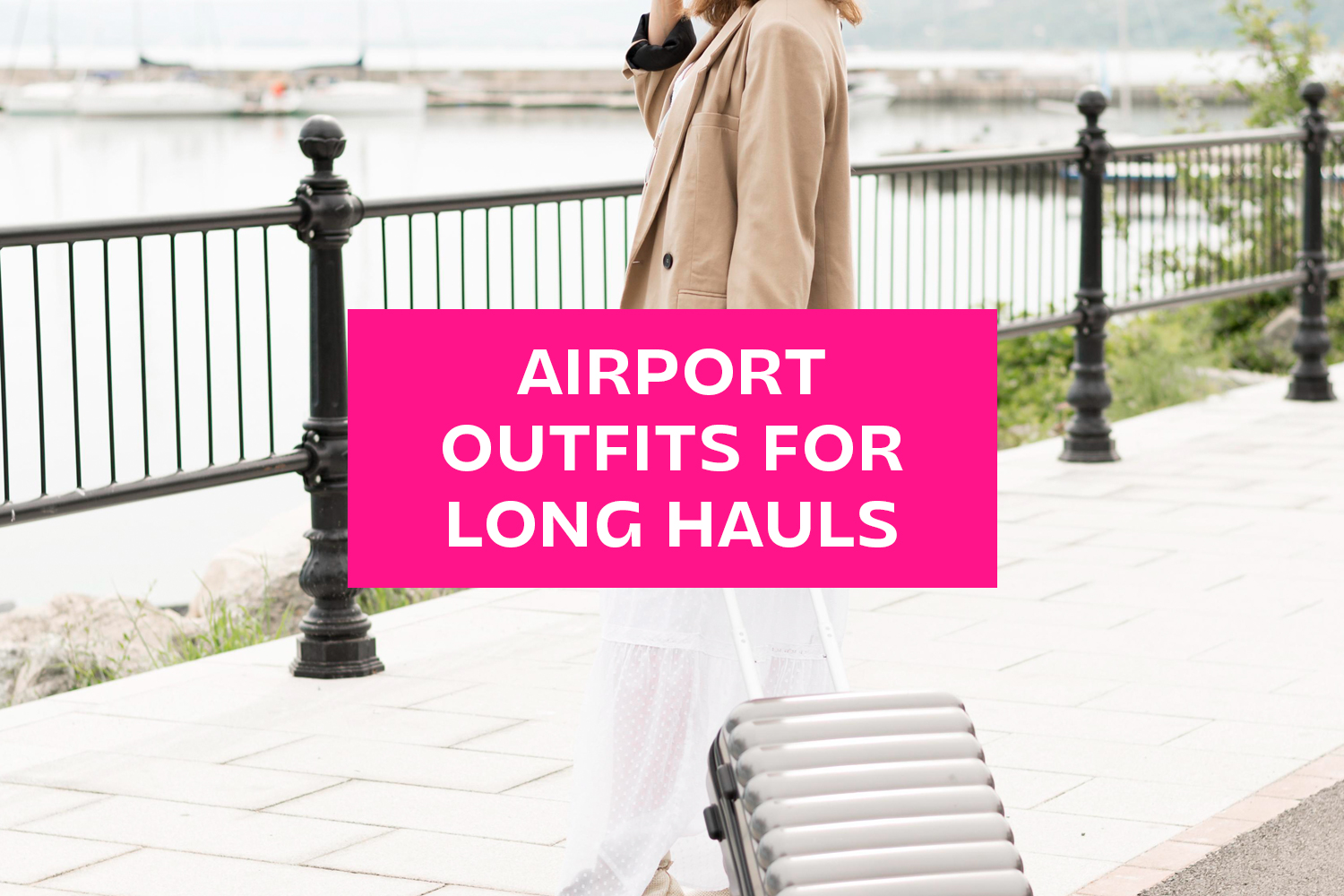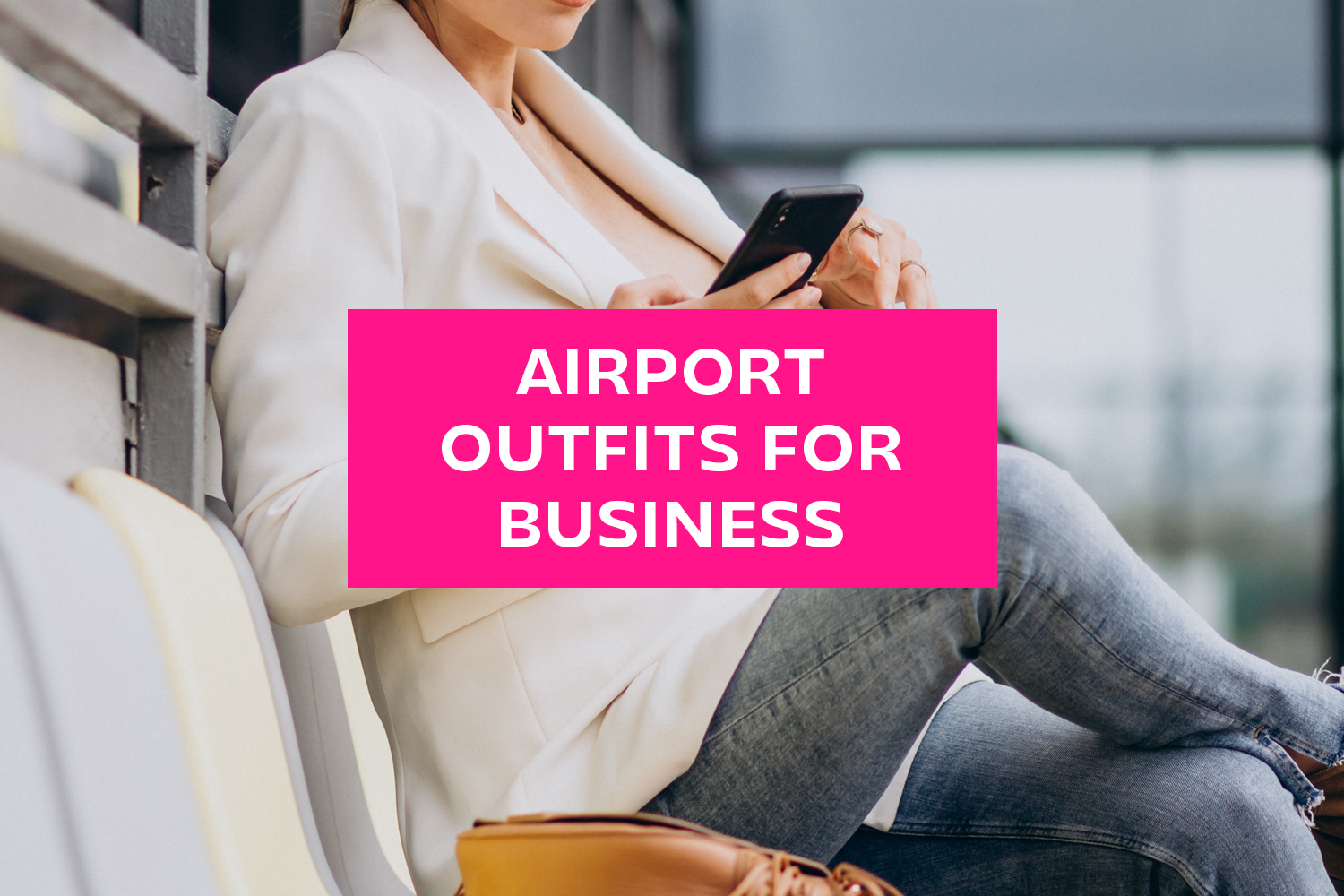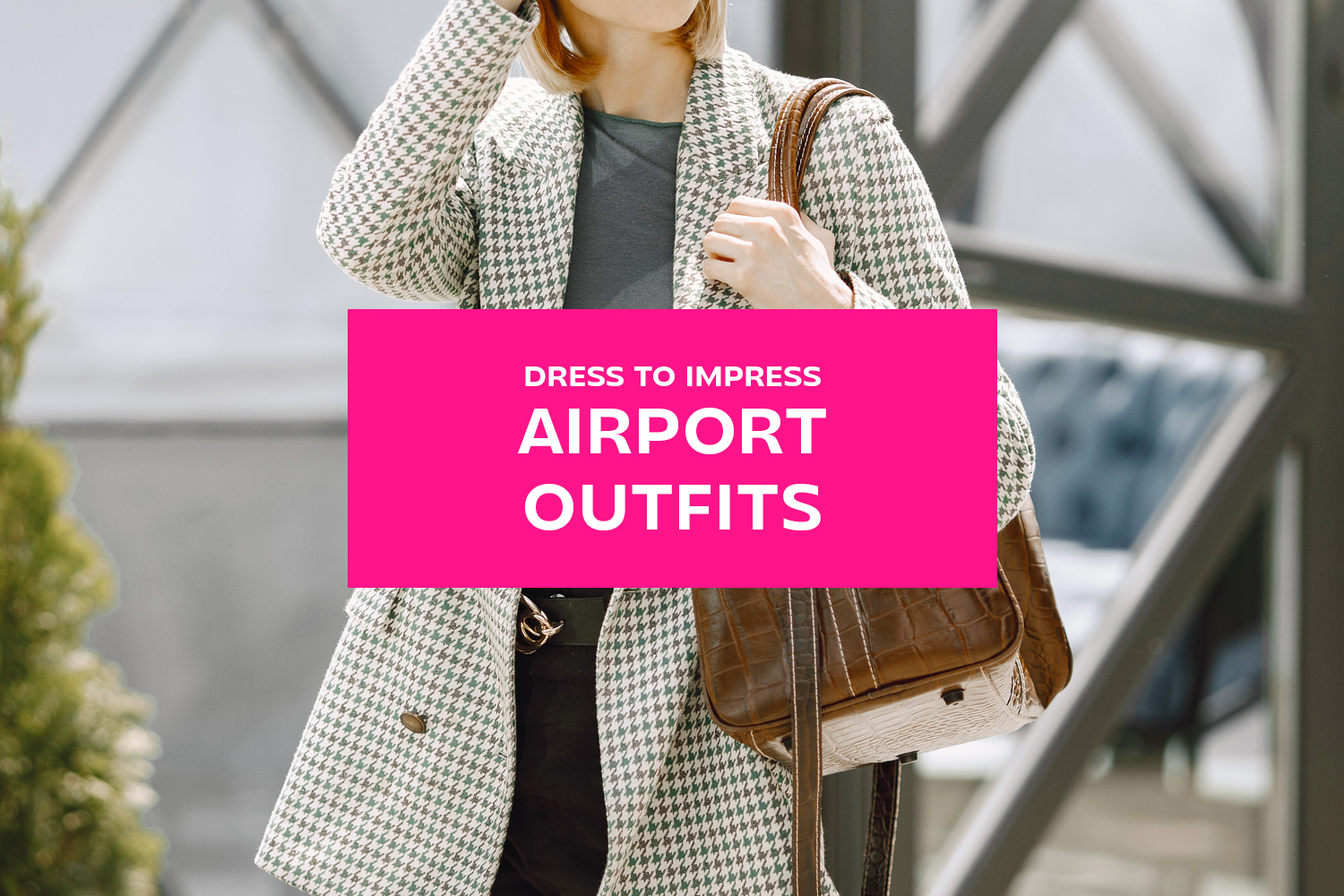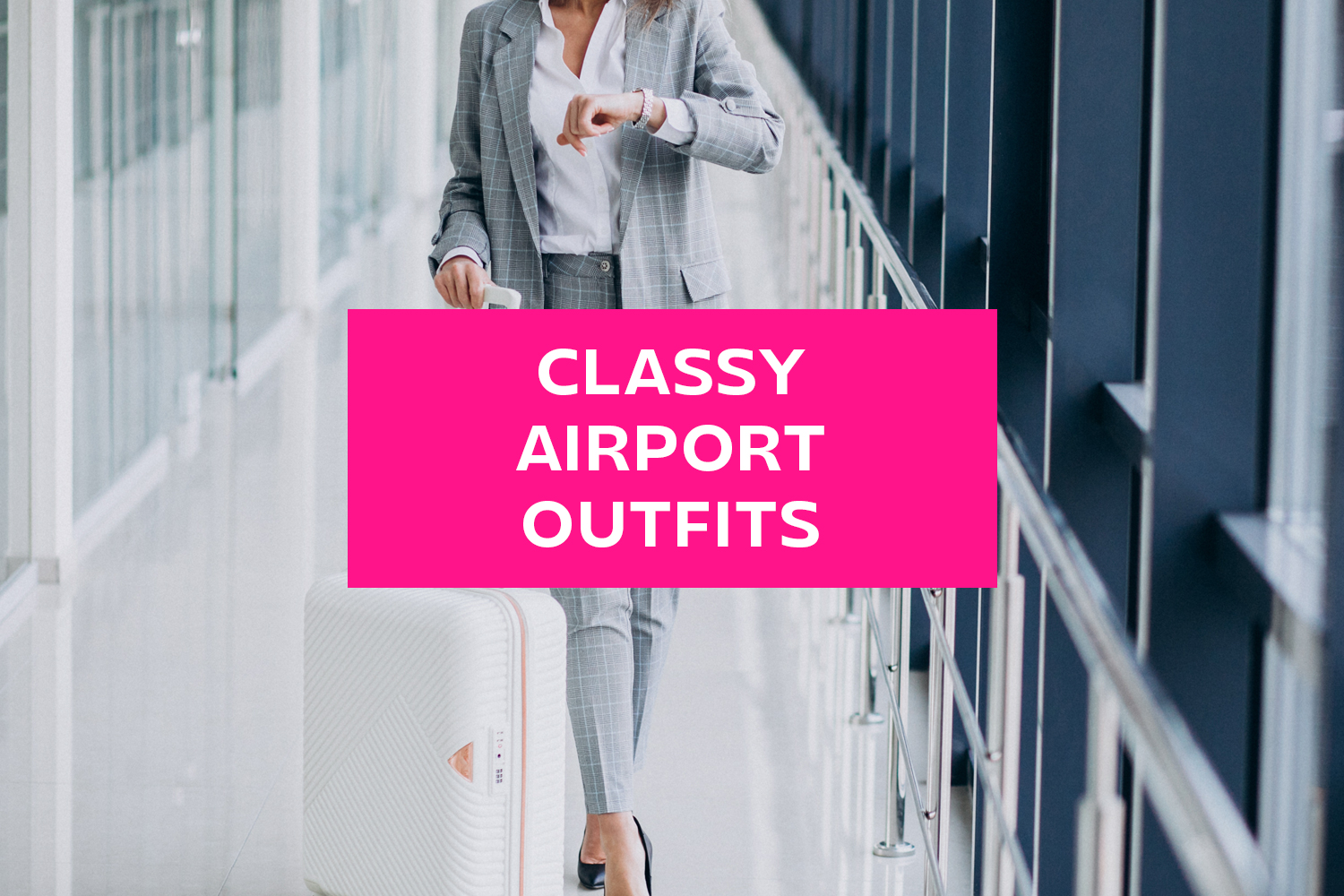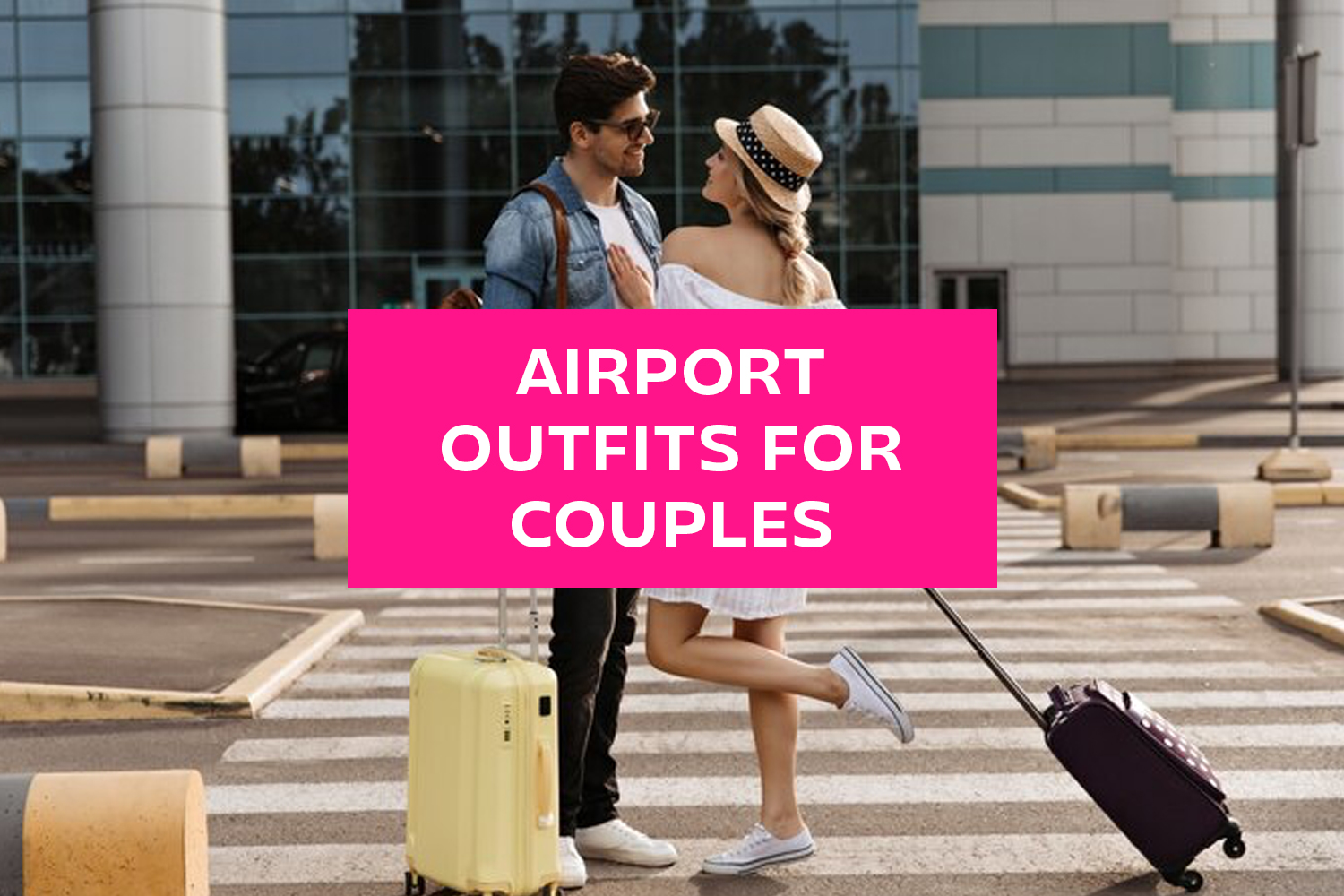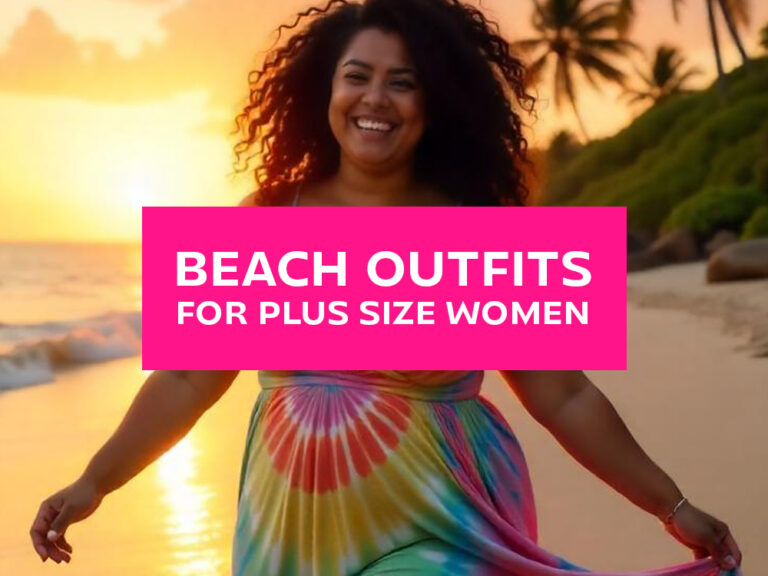Have you ever found yourself standing in front of your closet the night before a flight, completely stumped about what to wear? You’re not alone.
The airport fashion dilemma is real—that tricky balance between wanting to look put-together while also staying comfortable enough to endure hours of sitting, walking, and navigating crowded terminals.
Gone are the days when travelers dressed in their Sunday best to fly. Yet the pendulum has swung back from the ultra-casual sweats era too.
Whether you’re jetting off for a business meeting, embarking on a dream vacation, or making a quick weekend getaway, what you wear to the airport matters.
The right outfit can make security checks smoother, temperature changes more bearable, and those unexpected delays much less frustrating.
In this comprehensive guide, we’ll walk through everything you need to know about creating the perfect airport outfit.
Let’s dive in.
Our Collection of Airport Outfit Ideas
Comfort vs. Style
Finding the Perfect Balance
The age-old dilemma of comfort versus style becomes particularly pronounced when planning your airport outfit.
After all, you’re potentially facing hours of sitting in confined spaces, navigating terminals, and dealing with changing temperatures, all while wanting to look put-together upon arrival.
The good news? In 2025, this is no longer an either/or proposition.
The key to mastering airport fashion lies in understanding that comfort and style can coexist beautifully.
In fact, when done right, they enhance each other. Comfortable clothing that fits well and suits your body type naturally looks better than ill-fitting pieces you’re constantly adjusting.
Similarly, when you feel confident in your appearance, you’re more likely to be comfortable in a psychological sense, regardless of the physical attributes of your outfit.
Let’s break down why both elements matter:
The Comfort Imperative
Air travel presents unique physical challenges.
You might be sitting for extended periods, experiencing pressure changes that cause swelling, and moving through environments with wildly fluctuating temperatures.
Restrictive clothing can transform minor discomforts into major irritations over the course of a journey.
Comfort isn’t just about loose-fitting clothes, though. It encompasses:
- Freedom of movement: Can you reach the overhead bin without your shirt coming untucked or your pants feeling too tight?
- Temperature adaptability: Can you add or remove layers as needed?
- Breathability: Will your fabrics allow air circulation during those moments when the cabin feels stuffy?
- Pressure accommodation: Will your waistband dig in after hours of sitting? Will your shoes become torture devices if your feet swell?
When you prioritize these aspects of comfort, you’re setting yourself up for a more pleasant journey.
And a more pleasant journey means you arrive at your destination in a better mood, which is its own kind of style win.
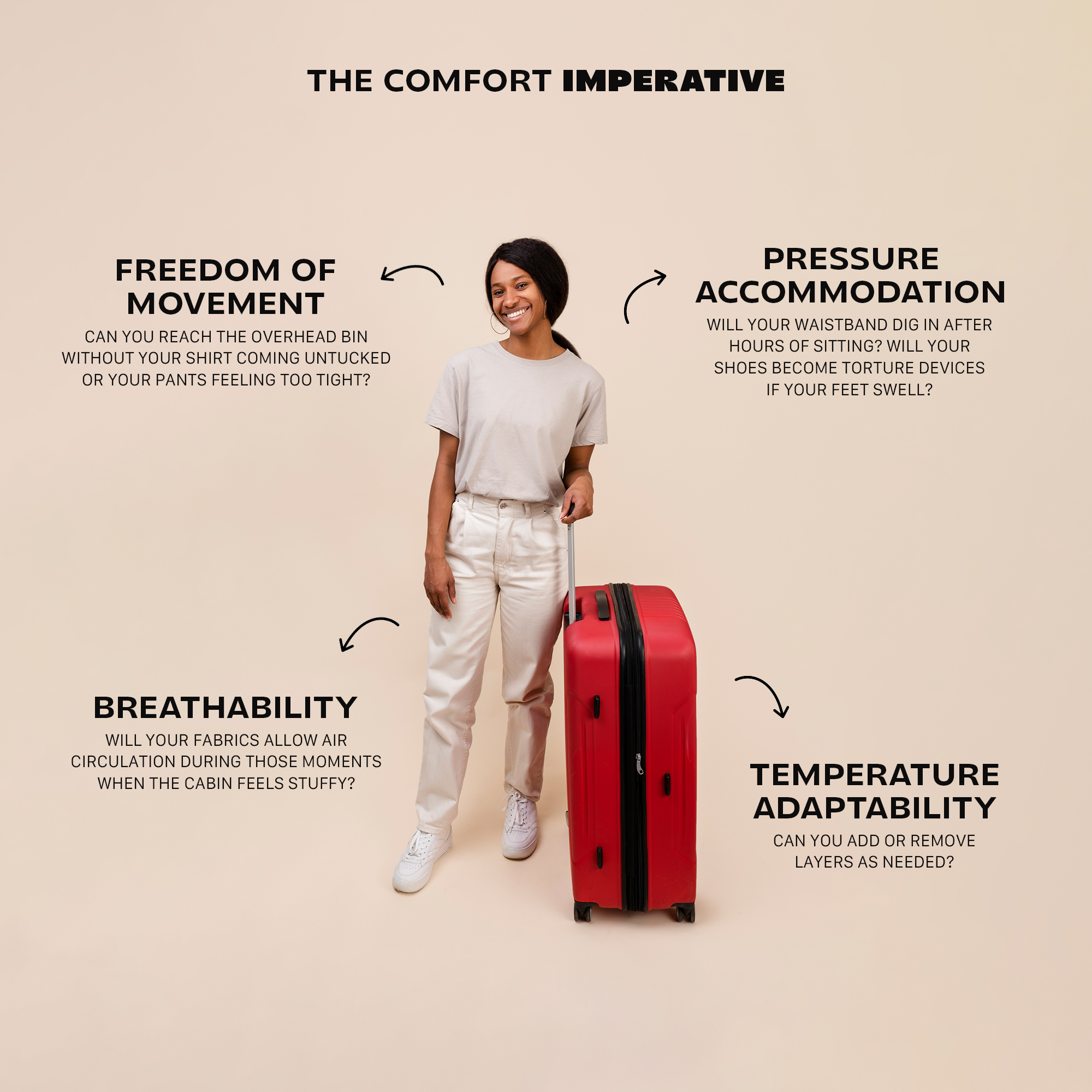
The Style Component
While comfort is essential, there’s undeniable value in maintaining your personal style while traveling:
- Confidence boost: Feeling good about your appearance can provide a psychological lift during the stress of travel.
- Practical benefits: You never know who you’ll meet at the airport or what opportunities might arise at your destination. Being presentable keeps options open.
- Transition readiness: A thoughtfully styled airport outfit can take you straight from the terminal to meetings, meals, or activities without requiring a complete change.
- Self-expression: Your clothing is a form of communication. Even at the airport, you’re telling a story about who you are.
The most successful airport outfits acknowledge both the physical realities of travel and the emotional benefits of maintaining your personal style.
Strategies for Balancing Both
Achieving the comfort-style balance isn’t about compromise—it’s about smart choices:
- Upgrade your basics: Instead of standard sweats, opt for elevated versions in better fabrics and more tailored cuts. A well-made pair of joggers in a premium material looks significantly more polished than their bargain-bin counterparts.
- Focus on fit: Properly fitting clothes are both more comfortable and more flattering. Avoid anything too tight (which restricts movement and comfort) or too loose (which can look sloppy).
- Embrace the power of the third piece: A simple formula for elevated casual looks is base layer + second layer + “third piece.” Your third piece might be a structured jacket, a beautiful scarf, or even a statement bag; something that elevates basic comfortable pieces.
- Consider your color palette: Coordinated neutrals always look more intentional than random combinations. A monochromatic outfit in particular can look sophisticated while being just as comfortable as a mismatched one.
- Pay attention to grooming: Sometimes the difference between “comfortably stylish” and “just rolled out of bed” is simply neat hair, minimal makeup, and clean, maintained clothing.
The psychology behind feeling good in what you wear shouldn’t be underestimated.
When you’ve thoughtfully chosen an outfit that honors both comfort and personal style, you’re likely to feel more confident, less stressed, and better equipped to handle the inevitable challenges of travel.
This mental comfort complements physical comfort, creating a positive feedback loop that enhances your entire travel experience.
Remember that finding your perfect balance is personal. Some travelers lean more toward the comfort end of the spectrum, while others prioritize style.
Neither approach is wrong because what matters is that your choices support your travel needs and make you feel your best as you journey from one place to another.
Essential Fabrics for Travel
When it comes to creating the perfect airport outfit, fabric choice can make or break your travel experience.
The right materials not only enhance comfort during long flights but also ensure you look fresh upon arrival.
In 2025, fabric technology and sustainable options have evolved significantly, giving travelers more choices than ever before.
Save for Later to Your Pinterest Board
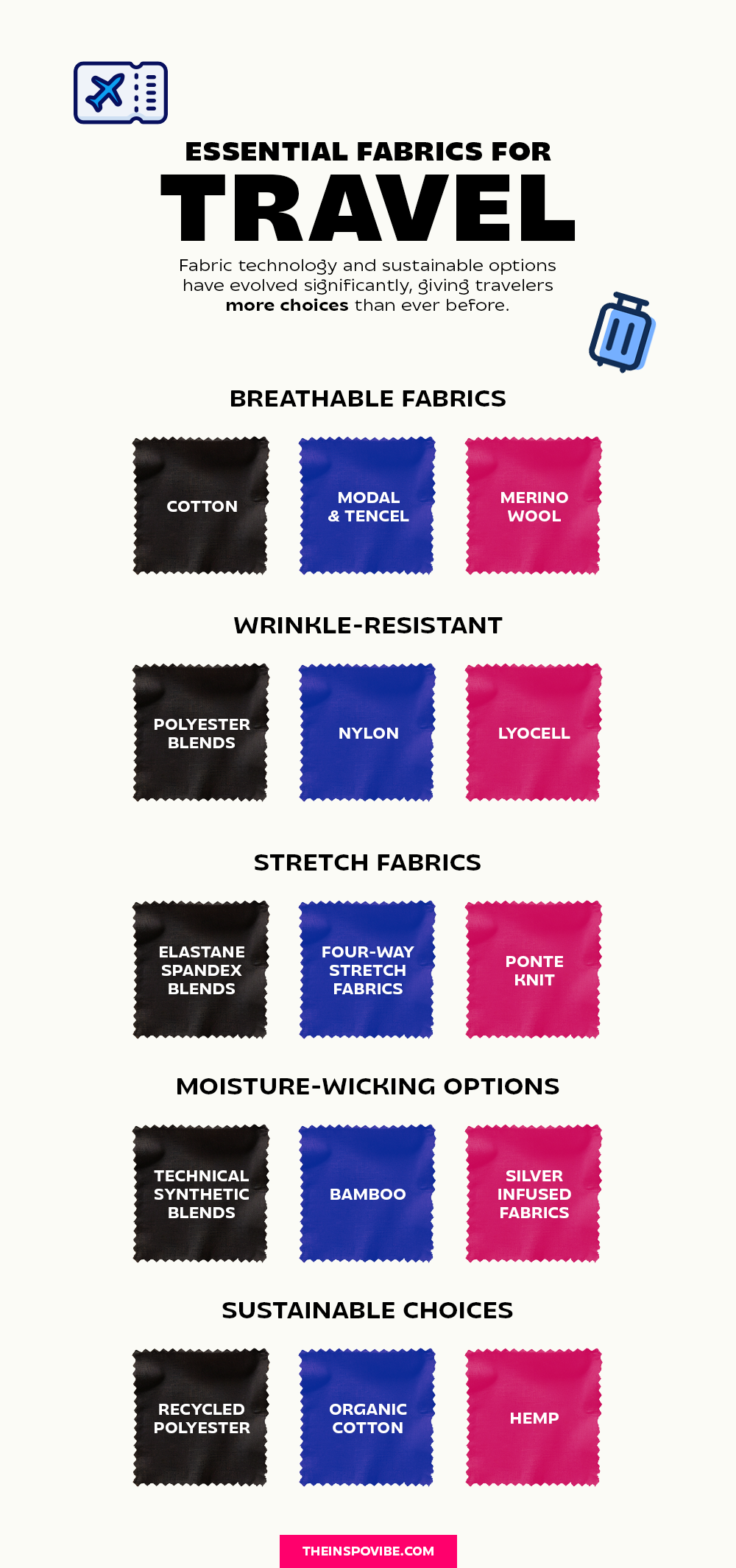
Breathable Fabrics
Breathability should be your top priority when selecting travel clothing.
Airplane cabins are notorious for their fluctuating temperatures. One moment you’re freezing, the next you’re overheating.
Breathable fabrics allow air to circulate, helping regulate your body temperature throughout these changes.
- Cotton: A perennial favorite, cotton remains popular for good reason. It’s natural, breathable, and comfortable against the skin. Opt for premium cotton blends that offer a bit of stretch for added comfort. The downside? Pure cotton wrinkles easily and can take time to dry if you get caught in unexpected rain at your destination.
- Modal and Tencel: These semi-synthetic fabrics derived from wood pulp offer the breathability of natural fibers with enhanced performance features. They’re exceptionally soft, drape beautifully, and resist wrinkles better than cotton. They’re also more sustainable than many synthetic options, making them perfect for eco-conscious travelers in 2025.
- Merino Wool: Don’t let the word “wool” fool you into thinking it’s only for winter. Lightweight merino wool is actually perfect for travel year-round. It’s naturally temperature-regulating, moisture-wicking, and perhaps most impressively, odor-resistant even after extended wear. A thin merino top can be worn multiple days without washing, making it ideal for minimalist packers.
Wrinkle-Resistant Materials
Nothing ruins a carefully planned travel outfit faster than emerging from a long flight looking like you slept in your clothes, even if you did!
These wrinkle-resistant options help you maintain a put-together appearance with minimal effort.
- Polyester Blends: While pure polyester has earned a bad reputation for being less breathable, modern polyester blends combine the wrinkle-resistance of synthetic fibers with the comfort of natural ones. Look for blends with cotton or rayon that offer the best of both worlds.
- Nylon: Lightweight and quick-drying, nylon is excellent for travel pieces that need to maintain their shape. It’s particularly good for outer layers like windbreakers or light jackets that might get stuffed into carry-ons.
- Lyocell: This sustainable fabric has excellent drape and natural wrinkle resistance. It feels luxurious against the skin while maintaining its appearance throughout long travel days.
- Travel-Specific Treated Fabrics: Many brands now offer clothing lines specifically designed for travel, featuring fabrics treated to resist wrinkles, stains, and odors. These technological advances mean you can find pieces that look like traditional workwear but perform like technical gear.
Stretch Fabrics
Airport days involve a lot more movement than you might expect; rushing to gates, contorting to retrieve items from overhead bins, sitting in cramped positions.
Fabrics with stretch accommodate these activities while maintaining their shape.
- Elastane/Spandex Blends: Even a small percentage (2-5%) of elastane in a fabric blend can dramatically improve comfort and movement. Look for this addition in everything from jeans to blazers for travel-friendly versions of classic pieces.
- Four-Way Stretch Fabrics: Originally developed for athletic wear, these fabrics have made their way into travel clothing for good reason. They stretch both horizontally and vertically, providing maximum freedom of movement while maintaining structure.
- Ponte Knit: This stable double-knit fabric offers the perfect balance of structure and stretch. It’s ideal for pants and skirts that need to look polished while remaining comfortable for long periods of sitting.
Moisture-Wicking Options
Long flights can leave you feeling less than fresh. Moisture-wicking fabrics draw sweat away from your body, allowing it to evaporate quickly and keeping you dry and comfortable.
- Technical Synthetic Blends: Fabrics designed for athletic performance work equally well for travel. Look for polyester or nylon blends specifically labeled as moisture-wicking.
- Bamboo: This sustainable option has natural moisture-wicking properties along with antibacterial qualities that help prevent odors—perfect for those marathon travel days.
- Silver-Infused Fabrics: A newer innovation in travel wear, these fabrics contain tiny silver particles that naturally fight bacteria and odor, helping you stay fresh even on the longest flights.
Sustainable Choices for Eco-Conscious Travelers
Sustainability has become a priority for many travelers, and the fabric industry has responded with innovations that reduce environmental impact without sacrificing performance.
- Recycled Polyester: Made from post-consumer plastic bottles, recycled polyester performs identically to virgin polyester but with a significantly reduced carbon footprint.
- Organic Cotton: Grown without harmful pesticides and using less water than conventional cotton, organic options provide the comfort you love with less environmental impact.
- Hemp: This durable, naturally antimicrobial fabric requires minimal water and no pesticides to grow. It’s becoming increasingly popular in travel wear for its sustainability credentials and natural temperature regulation.
When selecting fabrics for your airport outfit, consider the specific demands of your journey.
A short domestic flight might allow for different choices than a 15-hour international journey.
Similarly, your destination climate should influence your selections with breathability might be your top priority for tropical destinations, while layerable warmth could be more important for colder climates.
The best travel outfits often combine different fabrics strategically: moisture-wicking base layers, insulating mid-layers in natural fibers, and technical outer layers that resist wrinkles and stains.
This thoughtful combination ensures you’re prepared for whatever your journey brings while maintaining both comfort and style from takeoff to landing.
The Art of Layering
Layering is perhaps the single most important technique for creating a successful airport outfit.
It’s the secret weapon that allows you to adapt to unpredictable temperatures, add visual interest to simple pieces, and transition seamlessly between different climates.
In 2025, layering has evolved beyond simply piling on clothes. It’s now an art form that balances function and style.
Why Layering is Essential for Air Travel
Airports and airplanes present unique temperature challenges. You might encounter:
- Overheated terminals followed by frigid jet bridges
- Sun-baked tarmacs followed by aggressively air-conditioned cabins
- Departure from a snowy location and arrival at a tropical destination (or vice versa)
Even on a single flight, temperatures can fluctuate dramatically.
The cabin might be chilly during cruising altitude but warm during boarding and deplaning.
Without proper layering, you’re left either shivering or sweating; neither of which contributes to a comfortable travel experience.
Beyond temperature regulation, layering serves other practical purposes:
- Versatility: Layers can be added or removed to create different looks appropriate for various situations at your destination.
- Space-saving: Wearing layers rather than packing bulky items saves valuable suitcase space.
- Protection: Layers provide a barrier between you and shared surfaces in high-traffic travel environments.
The Science of Effective Layering
The most successful layering follows a three-part system:
#1 Base Layer: Your Foundation
Your base layer sits directly against your skin and serves as the foundation of your outfit. The primary function is moisture management and temperature regulation.
Key characteristics to look for:
- Breathable, lightweight fabrics
- Moisture-wicking properties
- Soft, non-irritating texture
- Fitted but not restrictive
Best options:
- Lightweight merino wool t-shirts or tanks
- Soft cotton or modal blend tops
- Technical fabrics designed for temperature regulation
- Seamless construction to prevent chafing
The base layer should be something you’re comfortable wearing on its own if the cabin becomes unexpectedly warm.
For women, this might mean a flattering t-shirt, a sleeveless turtleneck, or a lightweight long-sleeve top depending on the season and your personal comfort preferences.
#2 Mid Layer: Your Insulation
The mid layer provides warmth and serves as a bridge between your base and outer layers.
This is where you can add personality to your outfit while maintaining functionality.
- Insulating properties
- Easy to remove and put back on
- Complements both your base and outer layers
Best options:
- Lightweight sweaters or cardigans
- Button-up shirts (can be worn open or closed)
- Vests for core warmth without bulk
- Thin quarter-zip pullovers
The mid layer is often the most visible component of your outfit, so this is where you might incorporate color, texture, or pattern.
A beautiful cashmere cardigan, for example, adds luxury to simple travel basics while providing practical warmth.
#3 Outer Layer: Your Protection
The outer layer is your final defense against the elements and often the first impression you make.
It should be easy to remove when going through security and versatile enough to work at both your departure and arrival destinations.
Key characteristics to look for:
- Easy to take on and off
- Wrinkle-resistant
- Weather-appropriate
- Pockets for travel essentials
Best options:
- Unstructured blazers in knit or technical fabrics
- Lightweight jackets with water-resistant properties
- Oversized shirt jackets (“shackets”)
- Wraps or ponchos for maximum versatility
In 2025, many brands offer travel-specific outer layers with hidden pockets, packable designs, and fabrics that resist wrinkles even after being stuffed in an overhead bin.
Layering Techniques That Work
Beyond the basic three-part system, these specific techniques will elevate your layering game:
The Column of Color
Create a long, lean silhouette by wearing the same color (or very similar shades) in your base layer and bottoms.
This creates a “column” that elongates your frame and provides a clean backdrop for statement mid or outer layers.
For example, black leggings with a black fitted tee create a sleek foundation for a colorful cardigan or patterned jacket.
The Rule of Thirds
For the most flattering proportions, divide your body visually into thirds rather than halves.
This might mean wearing high-waisted bottoms with a tucked-in top and longer outer layer, or cropped pants with a longer top and short jacket.
This principle creates visual interest and balanced proportions.
Strategic Bulk Management
Place thinner layers closest to your body and gradually increase thickness as you move outward. This prevents bunching and maintains a streamlined silhouette.
Save textured, chunky, or oversized pieces for your outermost layer.
The Peek-Through Effect
Allow interesting details from inner layers to show through, for e.x, a lace-trimmed camisole under a V-neck sweater, or the collar and cuffs of a button-up beneath a crewneck top.
These small glimpses add dimension to your outfit without adding bulk.
Layering Without Overheating
One common concern with layering is the potential for overheating during parts of your journey. These strategies help prevent that issue:
- Choose breathable fabrics for every layer, not just the base
- Opt for sleeveless or short-sleeved inner layers when possible
- Select layers that can be fully opened (cardigans, button-ups, zip-ups) rather than pullovers
- Consider asymmetrical or partial layers like ponchos, wraps, or scarves that cover only portions of your body
- Use accessories as mini-layers that add warmth to specific areas without covering your entire body
Layering for Different Body Types
Layering works for every body type when done thoughtfully:
- Petite frames: Avoid overwhelming your frame with too many bulky layers. Stick to thin, fitted pieces and keep layers relatively short to maintain proportion.
- Tall frames: You can carry more substantial layers and longer lengths. Consider playing with proportion by mixing cropped pieces with longer ones.
- Curvy figures: Define your waist with at least one fitted layer, and consider open front layers that create vertical lines.
- Athletic builds: Use layers to create dimension and curves through strategic placement of volume and texture.
The beauty of layering for travel is that it combines practicality with personal expression.
As you master these techniques, you’ll develop a signature layering style that serves you well not just at the airport, but in many aspects of your wardrobe.
The perfect travel outfit isn’t about specific pieces but it’s about how thoughtfully you combine them to meet the unique demands of your journey.
Bottom Wear
Beyond Basic Leggings
When it comes to airport fashion, bottoms deserve special attention.
After all, you’ll be sitting in them for hours, possibly dealing with bloating from altitude changes, and needing to move comfortably through crowded terminals.
While basic black leggings have long been the default choice for many travelers, 2025’s airport style offers many more sophisticated and comfortable options.
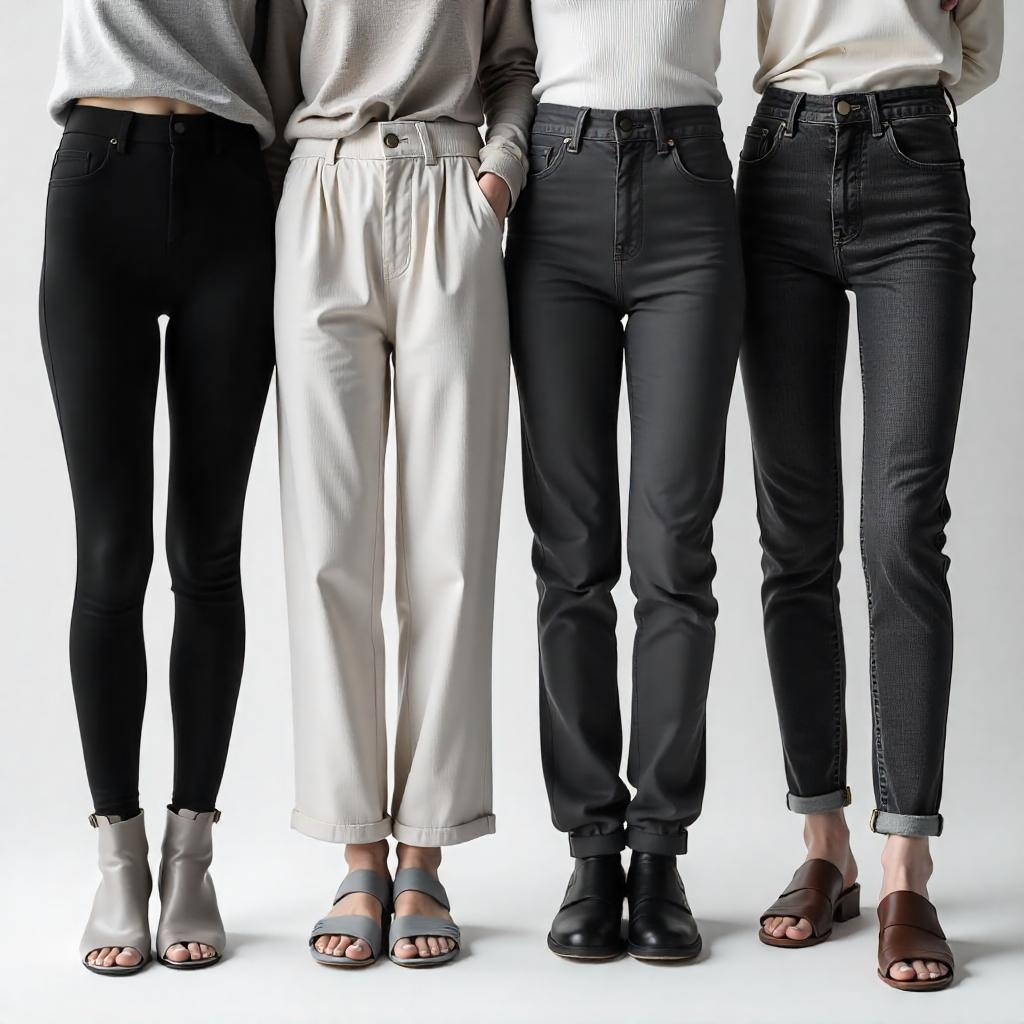
Elevated Leggings
Leggings remain a travel staple for good reason—they’re comfortable, packable, and versatile. However, in 2025, the basic black legging has received significant upgrades:
- High-waisted compression leggings: These provide gentle support for your core during long flights, which can help reduce bloating and discomfort. Look for pairs with a wide, non-binding waistband that won’t dig in when seated.
- Leggings with pockets: Functional pockets have become a non-negotiable feature for many travelers. Side pockets can hold your phone and boarding pass for easy access, eliminating the need to constantly reach for your bag.
- Textured and patterned options: Subtle textures like ribbing, jacquard patterns, or small geometric prints elevate leggings from basic to sophisticated. These details add visual interest without sacrificing versatility.
- Faux leather and suede-look leggings: For a more polished appearance, consider leggings in these elevated finishes. Modern versions incorporate enough stretch to remain comfortable while looking significantly more dressed up than their matte counterparts.
- Ponte knit leggings: Thicker than standard leggings but just as comfortable, ponte knit offers more structure and opacity, creating a more polished look that bridges the gap between leggings and pants.
To style leggings for travel, pair them with longer tops that cover the hip area, or layer under an oversized button-up or tunic.
This creates a balanced silhouette that looks intentional rather than like you simply wore gym clothes to the airport.
Wide-Leg Pants and Palazzo Options
Wide-leg pants have emerged as a favorite among fashion-forward travelers who prioritize both style and comfort.
The relaxed silhouette allows for air circulation and unrestricted movement while creating an effortlessly chic look.
- Flowy wide-leg pants: Often made from lightweight fabrics like rayon, modal, or silk blends, these create a dramatic, elegant silhouette without clinging to the body. They’re particularly good for hot weather destinations or travelers who tend to retain water during flights.
- Cropped wide-leg styles: These hit above the ankle, making them practical for navigating puddles on rainy tarmacs and keeping hems clean during travel. The shorter length also balances the volume of the wide leg.
- Palazzo pants with elastic waists: The combination of a forgiving waistband with the dramatic wide leg creates a comfortable yet statement-making travel option. In solid neutrals, these can look as sophisticated as formal trousers.
- Paper-bag waist styles: The gathered waistline detail adds visual interest while providing extra room for comfort during long periods of sitting. This style typically comes with a tie belt that can be loosened during the flight and tightened upon arrival for a more defined silhouette.
For maximum comfort, choose wide-leg pants in natural, breathable fabrics with a touch of stretch.
Pair them with fitted tops to balance the volume on bottom, and consider a cropped jacket or cardigan that hits at the waist to maintain proportion.
Joggers and Athleisure Bottoms
Comfort Without Looking Sloppy
The athleisure trend has revolutionized travel wear, with joggers leading the charge.
Today’s versions bear little resemblance to traditional sweatpants, offering a tailored look that’s appropriate for public spaces.
- Slim-fit joggers: With a tapered leg and fitted ankle cuff, these create a more streamlined silhouette than traditional sweatpants. Look for elevated fabrics like French terry, modal blends, or performance materials with a matte finish.
- Cargo joggers: Combining the comfort of joggers with the functionality of cargo pants, these offer multiple pockets for travel essentials while maintaining a fashionable silhouette. The 2025 versions feature sleeker, less bulky pocket designs than their utilitarian predecessors.
- Knit joggers: Made from fine-gauge knits rather than traditional sweatpant material, these have the comfort of loungewear with the appearance of more structured pants. They’re particularly good for overnight flights when you want to maximize comfort without looking like you’re wearing pajamas.
- Track pants with side stripes: The athletic-inspired stripe detail adds a fashionable edge to simple joggers. In 2025, look for subtle, tonal stripes rather than high-contrast options for a more sophisticated take on this trend.
To elevate joggers for travel, pair them with non-athletic tops and accessories.
A crisp button-up shirt, a fine-gauge sweater, or a structured jacket transforms joggers from gym wear to stylish travel attire.
Jeans
Which Styles Work for Travel and Which to Avoid
Denim has a complicated relationship with travel.
While jeans are versatile and can transition easily from the plane to your destination activities, traditional rigid denim can be uncomfortable during long flights.
If you’re committed to wearing jeans for travel, choose wisely:
- DO choose: Stretch denim with at least 2% elastane or spandex. The stretch component makes a dramatic difference in comfort during long periods of sitting.
- DO choose: Straight-leg or wide-leg styles that don’t restrict movement or circulation. The trending barrel and wide-leg jeans of 2025 are actually ideal for travel because they provide room through the thigh and knee.
- DO choose: Mid-rise or high-rise styles that won’t gap or slide down when you’re seated or bending to retrieve items from under the seat.
- AVOID: Ultra high-rise rigid denim, which can dig into your waist when seated for long periods.
- AVOID: Skinny jeans without stretch, which can restrict circulation—particularly problematic during flights when swelling is common.
- AVOID: Heavy, thick denim for long-haul flights. If you must wear substantial denim, save it for shorter trips.
Many denim brands now offer “travel jeans” specifically designed to address these concerns, featuring extra stretch, lighter weight fabrics, and details like hidden expandable waistbands.
Skirts and Dresses That Work for Travel
Skirts and dresses can be surprisingly practical travel options, offering airflow and freedom of movement while looking pulled together with minimal effort.
- Midi skirts in knit fabrics: The length provides coverage for cold airplane cabins while the knit construction allows for stretch and comfort. These pair beautifully with sneakers for a balanced casual-chic look.
- Wrap dresses: The adjustable closure accommodates the slight bloating that often occurs during flights, and the classic silhouette transitions well from travel to destination activities.
- T-shirt dresses: Essentially an elongated tee, these one-piece wonders offer the comfort of loungewear with a more put-together appearance. Layer with a denim jacket or cardigan for warmth.
- A-line skirts with stretch waistbands: The flared shape allows for easy movement while the forgiving waistband remains comfortable throughout your journey.
When wearing skirts or dresses for travel, consider a few practical points: opt for opaque fabrics or wear bike shorts underneath, choose wrinkle-resistant materials, and be mindful of length for comfort when seated for extended periods.
Practical Considerations for Travel Bottoms
Regardless of which style you choose, keep these factors in mind when selecting bottoms for travel:
- Waistband comfort: Avoid tight, rigid waistbands or styles that dig in when seated. Partially elasticized waists offer a good compromise between structure and comfort.
- Bathroom practicality: Consider how easily your bottoms can be managed in tiny airplane bathrooms. Complicated closures or very full styles can be challenging in confined spaces.
- Wrinkle resistance: Check how your chosen bottoms look after sitting for an extended period. Some fabrics and styles show wrinkles more prominently than others.
- Versatility at your destination: Ideally, your travel bottoms should work for at least some of your planned activities upon arrival, saving valuable suitcase space.
he perfect travel bottom ultimately depends on your personal style, destination, and comfort preferences.
By moving beyond basic leggings and considering the full range of options available in 2025, you can find airport bottoms that serve both your comfort needs and style aspirations.
Footwear
When it comes to creating the perfect airport outfit, footwear deserves special attention.
Your choice of shoes can make the difference between breezing through security with ease and struggling with complicated laces while fellow travelers sigh impatiently behind you.
More importantly, the right travel shoes support you through miles of terminal walking, hours of sitting, and the inevitable mad dash to a connecting gate.
The Importance of Comfortable Shoes for Airport Navigation
Airports are essentially massive walking venues.
From the parking garage to check-in, through security, to your gate, and then potentially to connections, you might log several miles before even reaching your destination.
Add in the weight of carry-on bags, and the stress on your feet multiplies.
Beyond pure distance, airport walking presents unique challenges:
- Hard, unforgiving surfaces like tile and concrete
- Long periods of standing in security and boarding lines
- Rushing to make tight connections
- Navigating escalators and moving walkways
- Potential swelling at high altitudes
All these factors make comfort the non-negotiable priority for airport footwear.
However, in 2025, “comfortable shoes” no longer means sacrificing style for function.
The latest travel footwear options brilliantly merge support, practicality, and fashion-forward design.
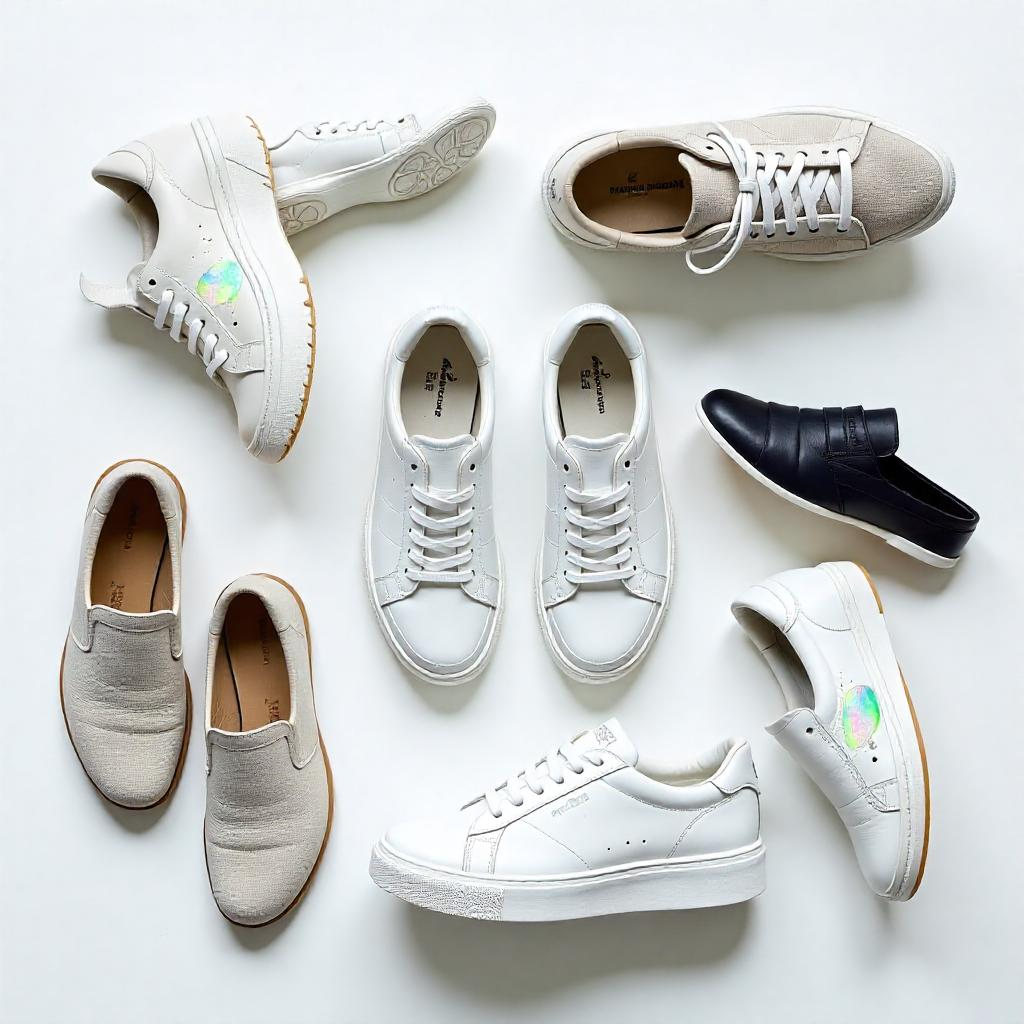
Slip-On Options That Make Security Checks Easier
The security checkpoint remains one of the most stressful parts of air travel, and your choice of footwear can significantly impact your experience.
Slip-on styles eliminate the fumbling with laces while balancing on one foot; a particularly welcome feature when you’re managing other items like laptops and liquids bags.
- Loafers: The classic loafer has experienced a major renaissance in travel fashion. Look for versions with cushioned insoles and flexible outsoles that combine the ease of a slip-on with the support of a more structured shoe. Leather or suede loafers in neutral colors work with virtually any travel outfit, while still looking polished enough for business meetings upon arrival.
- Mules: The backless design makes mules incredibly easy to slip off at security. In 2025, structured mules with supportive footbeds have replaced flimsy versions, offering better stability for airport walking. Closed-toe options provide more protection in crowded spaces and are appropriate for most professional settings.
- Slip-on sneakers: Combining the comfort of athletic shoes with the convenience of slip-ons, these hybrid styles have become airport staples. Brands now offer memory foam insoles, knit uppers that accommodate slight swelling, and sophisticated designs that don’t scream “casual.”
- Ballet flats with elastic: Traditional ballet flats can lack support for extensive walking, but the newest travel-friendly versions incorporate elastic tops for easy on-off, plus enhanced cushioning and arch support. Packable versions can be stowed in your carry-on if you prefer to wear bulkier shoes on the plane but want options at your destination.
When choosing slip-on footwear for travel, look for secure fits that won’t slide off while walking.
A shoe that requires constant toe-gripping to keep it on will leave you with tired, achy feet before you even board.
Stylish Sneakers That Provide All-Day Comfort
Sneakers have firmly established themselves as acceptable footwear in nearly all settings, including business casual environments in many industries.
This mainstream acceptance has made them the go-to choice for travelers who prioritize comfort without wanting to look overly casual.
- Knit sneakers: The flexible, sock-like uppers of knit sneakers accommodate foot swelling during flights while providing breathability. Their lightweight construction makes them ideal for packing if you choose to wear different shoes on the plane.
- Leather sneakers: More polished than their canvas counterparts, leather sneakers offer a sophisticated option that transitions well from travel to meetings or dinners. White leather sneakers remain a versatile classic, while 2025 has seen the rise of subtle metallics and rich earth tones as alternatives.
- Platform sneakers: Adding a bit of height without the discomfort of heels, platform sneakers with 1-2 inch soles provide extra cushioning between your feet and hard airport floors. Look for lightweight versions that won’t weigh you down during long walks.
- Retro-inspired athletic shoes: Vintage-looking runners from the 70s and 80s have made a strong comeback, offering both nostalgic style and modern comfort technology. Their slightly chunky silhouettes pair well with both casual and more dressed-up travel outfits.
For maximum comfort, look for sneakers with removable insoles (so you can insert your own orthotics if needed), adequate arch support, and cushioning in the heel and ball of the foot where impact stress is greatest.
Loafers and Flats That Elevate Travel Looks
When your travel plans include business meetings or upscale events upon arrival, you might want footwear that skews more polished while still offering comfort for the journey.
- Driving loafers: Originally designed for, yes, driving, these shoes feature flexible construction and often have rubber nubs on the sole for traction. This design translates well to airport travel, providing comfort while maintaining a put-together appearance.
- Pointed-toe flats with cushioning: The pointed toe elongates the leg line for a more dressed-up look, while modern cushioning technology makes these much more comfortable than their predecessors. Look for brands that specifically advertise comfort features like padded heel collars and foam insoles.
- Smoking slippers: These elegant, minimalist slip-ons offer a refined alternative to casual shoes. Velvet versions add a touch of luxury to simple travel outfits, while leather or suede options provide more durability for extensive walking.
- Low block heels: If you absolutely must have some height, a shoe with a low (1-2 inch) block heel offers more stability and comfort than stilettos or kitten heels. Reserve these for shorter flights where you won’t be doing extensive terminal walking.
When selecting dressier shoes for travel, always prioritize comfort features like padded insoles, flexible soles, and non-binding uppers. Even the most elegant shoe should allow you to walk comfortably for at least a mile.
Boots & How to Wear Them Efficiently Through Security
Boots present a particular challenge for air travel. They’re often the preferred footwear for cold-weather destinations, but their laces or zippers can make security a hassle.
If you’re committed to traveling in boots, consider these options:
- Chelsea boots: The elastic side panels make these boots easy to slip on and off without sacrificing style or support. Look for versions with cushioned insoles for additional comfort during long travel days.
- Ankle boots with side zippers: These provide more ankle support than slip-on styles while still being relatively easy to remove at security. The shorter height also makes them less cumbersome to pack if you’re wearing them to save luggage space.
- Pull-on riding boots: If you need tall boots for your destination, look for pull-on styles without laces or complicated buckles. Some newer designs incorporate stretch panels for easier on-off and better fit around the calf.
- Combat boots with speed lacing: For those committed to the combat boot aesthetic, look for pairs with speed lacing systems or side zippers that allow you to loosen them quickly at security without completely unlacing.
To make the security process smoother when wearing boots:
- Loosen laces before getting in the security line
- Wear socks you don’t mind being seen in public
- Consider using the seated area to remove and put on boots rather than balancing at the bins
- Wear pants that can be easily tucked in and out of boots
Compression Socks
Benefits and Stylish Options
Long flights increase the risk of blood pooling in the lower legs, which can cause swelling, discomfort, and in rare cases, more serious conditions like deep vein thrombosis.
Compression socks help mitigate these risks by applying graduated pressure to improve circulation.
The good news for fashion-conscious travelers is that compression socks have undergone a style revolution.
No longer limited to medical-looking beige tubes, today’s options include:
- Subtle patterns: Herringbone, small dots, and geometric designs add interest while remaining professional and versatile.
- Fashion colors: Beyond basic black, compression socks now come in rich jewel tones, pastels, and even metallics to complement your travel outfit.
- Different heights: From knee-high to ankle length, you can choose the coverage that works best with your outfit and travel needs.
- Varying compression levels: For most travelers, light to medium compression (15-20 mmHg) provides benefits without discomfort. Those with specific medical concerns should consult their doctor for recommendations.
To incorporate compression socks into your travel outfit stylishly, consider them an intentional accessory rather than a hidden necessity.
With pants, choose a color that coordinates with your outfit.
With skirts or dresses, opt for a pattern or texture that looks deliberate rather than purely functional.
Special Considerations for Different Types of Travel
Your footwear needs may vary depending on your specific travel circumstances:
- Business travel: Prioritize shoes that transition well from the plane to meetings. Leather loafers, sleek ankle boots, or sophisticated flats in neutral colors offer versatility.
- Family travel with children: Hands-free is the priority here. Slip-on styles allow you to manage children and their gear without the added complication of tying shoes.
- Adventure travel: If your destination involves outdoor activities, consider wearing your bulkiest shoes (like hiking boots) on the plane to save luggage space, but bring slip-on options for security.
- Long-haul international flights: Prioritize shoes that accommodate swelling and can be easily removed for comfort during the flight. Consider bringing foldable slippers for walking around the cabin.
The perfect travel shoe balances comfort, convenience, and style in proportions that make sense for your specific journey.
By considering both the demands of airport navigation and your needs upon arrival, you can select footwear that enhances rather than detracts from your travel experience.
Accessorizing Your Airport Look
Accessories are the unsung heroes of airport fashion. They can transform basic travel staples into personalized, stylish outfits while serving practical purposes that make your journey smoother.
In 2025, travel accessories have evolved to become both more functional and more fashion-forward, allowing you to express your personal style without sacrificing practicality.
Practical Accessories
The best travel accessories earn their place in your outfit by performing double (or even triple) duty:
#1 Oversized scarves: Perhaps the most versatile travel accessory, a generously sized scarf can function as:
- A wrap for warmth in chilly cabins
- A makeshift pillow or lumbar support
- A privacy screen when napping
- A cover-up for conservative destinations
- A style statement that adds color and texture to simple outfits
Look for natural fibers like cashmere, merino wool, or modal that provide warmth without bulk and resist wrinkles.
Neutral patterns with multiple colors give you the most styling options at your destination.
#2 Convertible bags: These ingenious designs can transform from totes to backpacks to crossbody styles, adapting to different phases of your journey.
When rushing through terminals, switch to backpack mode to free your hands; when navigating narrow airplane aisles, convert to a crossbody to avoid bumping other passengers.
#3 Multi-pocket travel vests: For those who prefer to keep essentials on their person rather than in a bag, modern travel vests offer streamlined alternatives to the bulky photographer vests of the past.
With thoughtfully placed pockets for passports, phones, and other small items, they provide security without sacrificing style.
#4 Tech-friendly jewelry: In 2025, smart accessories have become increasingly sophisticated and stylish.
From rings that function as contactless payment devices to bracelets that store your boarding pass information, these pieces combine fashion with cutting-edge functionality.
Scarves
The humble scarf deserves special attention in any discussion of travel accessories.
Beyond its obvious function of providing warmth, a well-chosen scarf can be the most hardworking item in your travel wardrobe.
Material considerations: For maximum versatility, choose scarves in:
- Lightweight cashmere or wool for warmth without bulk
- Modal or silk blends for elegant drape and comfort against skin
- Wrinkle-resistant fabrics that look fresh even after being stuffed in a bag
Styling techniques for travel:
- The classic loop: Simple and secure, this won’t come undone during your journey
- The loose drape: Elegant and easy to adjust for temperature changes
- The full wrap: Provides maximum warmth, essentially functioning as an extra layer
- The belted scarf: Adds structure to oversized tops and creates waist definition
Color and pattern strategy: Choose scarves that incorporate multiple colors from your travel wardrobe to maximize outfit combinations.
A scarf with navy, gray, and burgundy, for example, can tie together various neutral pieces while adding visual interest.
Practical tips:
- Roll rather than fold your scarf when not wearing it to minimize creases
- Opt for designs without fringe if you’ll be using it as a pillow (to avoid irritation)
- Consider antimicrobial treatments for scarves that will serve multiple functions
Jewelry
What Works and What to Avoid During Security
Jewelry requires special consideration for air travel, balancing style preferences with practical security concerns.
Security-friendly options:
- Silicone or wooden bangles that won’t trigger metal detectors
- Lightweight statement earrings in plastic, resin, or coated metals
- Pendant necklaces that can be easily removed if necessary
- Watches with fabric or leather straps
Pieces to avoid:
- Heavy metal cuffs or bangles that are difficult to remove quickly
- Jewelry with sharp edges that might catch on seats or clothing
- Extremely valuable pieces that could be lost or damaged
- Multiple rings that would be time-consuming to remove at security
When wearing jewelry for travel, less is often more.
A few carefully chosen pieces can elevate your look without becoming burdensome or causing delays at security checkpoints.
Hats
Style and Practicality for Travel Days
Hats serve both aesthetic and practical purposes for travelers.
They can conceal travel-day hair, provide sun protection at your destination, and add personality to simple outfits.
Travel-friendly hat styles:
- Packable fedoras with flexible brims that spring back to shape
- Baseball caps for casual comfort and sun protection
- Beanies that add warmth without taking up much space
- Wide-brim hats with UPF protection for sunny destinations
Packing and wearing tips:
- Wear your bulkiest hat on the plane to save luggage space
- For packable styles, stuff the crown with soft items like socks to maintain shape
- Consider hat clips or straps for windy destinations
- Choose neutral colors that coordinate with multiple outfits
Style considerations:
- Balance hat proportions with your outfit (larger hats work well with streamlined clothing)
- Consider the climate at both departure and arrival points
- Remember that hats make a strong style statement as they can define your entire look
Sunglasses
Necessity for Arrival and Style Statement
Sunglasses are non-negotiable travel accessories that protect your eyes while adding instant polish to any outfit.
Practical benefits:
- Shield eyes from harsh airport lighting and jet lag-induced sensitivity
- Provide privacy during red-eye arrivals
- Protect against UV exposure when arriving in sunny destinations
- Allow you to skip eye makeup for early flights
Frame styles that work for travel:
- Oversized frames that provide maximum coverage and statement appeal
- Classic aviators that complement virtually any face shape and outfit
- Foldable designs that pack compactly in carry-ons
- Polarized lenses that reduce glare, especially useful when arriving in sunny locations
When selecting sunglasses for travel, consider both your face shape and the overall aesthetic of your travel wardrobe.
A versatile pair in a neutral color like black, tortoiseshell, or gold will complement most outfits.
Tech Accessories as Fashion Statements
In 2025, the line between technology and fashion has blurred significantly, with tech accessories becoming style statements in their own right.
Stylish headphones and earbuds:
- Over-ear headphones in premium materials like leather and aluminum
- Earbuds with decorative charging cases that resemble jewelry boxes
- Customizable options with interchangeable parts to match your outfit
- Noise-canceling capabilities for peaceful journeys
Smartwatches and fitness trackers:
- Minimalist designs that pair with both casual and formal travel wear
- Interchangeable bands to coordinate with different outfits
- Models that track sleep and jet lag recovery
- Travel-specific features like currency conversion and language translation
Phone cases and accessories:
- Crossbody phone cases that double as micro-purses
- Wallet cases that streamline what you need to carry
- Ring stands and grips in metallics or patterns that complement your personal style
- Power banks disguised as fashionable clutches or compacts
When selecting tech accessories for travel, look for pieces that align with your overall aesthetic while providing the functionality you need.
The days of sacrificing style for technology are firmly behind us.
The Perfect Travel Bag
Your travel bag is more than just a place to stash your essentials.
It’s a critical component of your airport outfit that impacts both your comfort and style.
The right bag complements your look while keeping necessities organized and accessible throughout your journey.
Carry-On Bag Essentials and Style Considerations
When selecting a carry-on bag for air travel, several factors deserve careful consideration:
#1 Size and capacity: Your primary carry-on should be spacious enough to hold in-flight essentials but compact enough to fit under the seat in front of you if necessary.
The ideal bag accommodates:
- Tech devices and chargers
- Comfort items like a neck pillow and eye mask
- Refreshment essentials such as a water bottle and snacks
- Entertainment options like books or tablets
- A light layer for temperature changes
#2 Accessibility: The best travel bags feature thoughtful organization that allows you to retrieve frequently needed items without digging through everything.
Look for:
- External pockets for boarding passes and ID
- Dedicated tech compartments with easy access
- Water bottle holders on the exterior
- Quick-access pockets for items you’ll need during security screening
#3 Durability: Airport environments can be tough on bags, with rough surfaces, tight spaces, and frequent handling.
Quality materials and construction details make a significant difference:
- Reinforced stitching at stress points
- Water-resistant or waterproof fabrics
- Sturdy hardware that won’t break or catch
- Abrasion-resistant bottom panels
#4 Comfort: Remember that you’ll be carrying or wearing this bag through potentially long distances.
Ergonomic features matter:
- Padded, adjustable straps
- Weight distribution that doesn’t strain your shoulders or back
- Breathable materials where the bag contacts your body
- Balanced design that doesn’t become awkward when fully packed
#5 Style compatibility: Your bag should harmonize with your overall travel aesthetic. Consider:
- Color coordination with your most frequent travel outfits
- Design details that reflect your personal style
- Versatility to work with both casual and more polished looks
- Appropriate level of formality for your typical travel purposes
Wrap up
The journey to creating the perfect airport outfit is both an art and a science.
What becomes clear is that the ideal airport outfit isn’t a one-size-fits-all formula.
Rather, it’s a thoughtful combination of elements that address your specific travel needs, personal style preferences, and practical considerations.
The perfect ensemble balances comfort with style, practicality with personal expression, and versatility with purpose.

